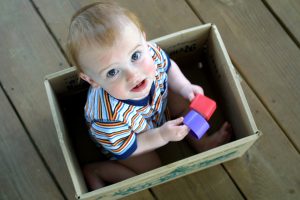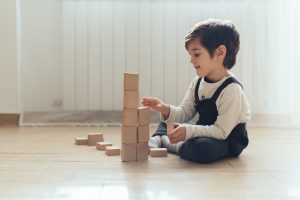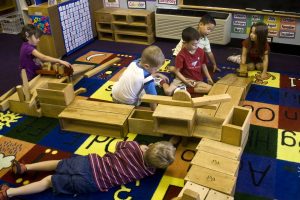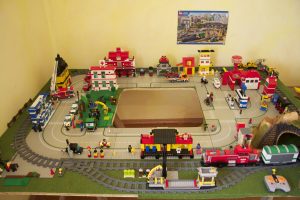Blocks
“Creative materials are, by definition, open-ended, divergent, abstract in design, freeform, and responsive to one’s actions on them – all characteristics that ensure that unit blocks are a most treasured type of creative play material” (Shipley, 2012, pg. 377)
Blocks have been recognized as valuable play materials since Friedrich Froebel (1782-1852) incorporated them into his kindergartens. Blocks provide opportunities for development in all domains for all ages of children. As a play material, they are particularly dynamic and responsive to the actions of the child.
7.1 Types of Blocks
Carolyn Pratt (1867-1954) is credited with creating the unit block system made up of solid wooden blocks. Unit blocks are standard proportions to promote mathematical concepts. A complete set of unit blocks (750 pieces) includes the following shapes:
|
Unit (14 cm x 7 cm x 3.5 cm)
|
Ramp
|
|
Square (½ unit)
|
Small column
|
|
Double unit
|
Large column
|
|
Quadruple unit
|
Half arch
|
|
Ellipse
|
Small buttress
|
|
Curve
|
Large buttress (flat edge)
|
|
Quarter circle
|
Large buttress (curved edge)
|
|
Gothic door
|
Arch
|
|
Large switch
|
Half circle
|
|
Small switch
|
Roof board
|
|
Switch or intersection
|
Pillar
|
|
Small triangle
|
Half pillar
|
|
Large triangle
|
Other types of blocks include hollow wooden blocks, smaller tabletop building blocks, foam rubber blocks, and cloth blocks, blocks made of more lightweight cardboard, and Cuisenaire Rods.
Duplo, Mega Blocks, and Lego are often considered to be blocks, but they are distinct from traditional blocks because they have an interlocking mechanism to hold them together. The basic interlocking bricks of these products have some open-ended play value. However, the more complex sets of Lego that must be put together in a specific way to create a finished product are of limited value when the goal is to encourage creativity, representational thinking, and spatial skills. For these reasons, Lego should not be substituted for other types of blocks that encourage creative expression.
Nor should unit blocks be combined with other play materials. According to Shipley (2012), “The key to play with unit blocks is to encourage children to use the blocks alone and not combine them with other play materials or detailed accessories, such as dump trucks or Fisher-Price items. The abstract nature of the unit blocks contributes to children’s ability to hold on to their inner vision and assign meaning to an abstract structure.” (Shipley, 2012, pg. 377)
7.2 Stages of Block Play
Carrying: A toddler’s first interactions with blocks usually involves just carrying them around or banging two blocks together.

Stacking: During this stage, toddlers may attempt to stack three to four blocks to create a tower.

Bridging: Supporting a horizontal block on top of two vertical blocks is called “bridging.” Preschoolers are becoming more capable of the complex cognitive processes needed: planning which blocks to use, predicting what might happen, estimating how far apart to place the vertical blocks

Enclosures: Preschoolers will place blocks so they touch and create a space that is closed off on all sides. Typically, it is not until children are between 5 and 7 years of age that they use additional blocks inside of an enclosure to represent things; for example, furniture in a house or a car in a garage.

Patterns: During this stage, block play remains horizontal (that is, on the floor) for the most part. The concept of symmetry is explored by creating elaborate patterns with assorted block shapes.

Representation 1: Creations become three-dimensional representations of real-world structures. Constructions are named and have a purpose.
Representation 2: Complex constructions such as houses and castles. Children begin to plan what they are going to build, often replicating familiar structures.

7.3 Block Play and Math
When children play with blocks they are practicing:
- Classification and seriation when they select blocks of differing sizes, shapes, and volumes
- Sorting similar and dissimilar shapes when tidying up
- Counting and measuring
- Estimating and predicting
- Spatial configurations
Educators can enhance exposure to mathematical concepts by asking the child questions about:
Size: How many blocks do we need to make the tower as tall as you? Will there be enough room in the garage you are building for all your cars to fit?
Shape: What is the shape of the house you are building? How many sides will it have? These two triangular blocks you put together are the same size as this square block. How come?
Orientation: I see you are trying to fit the blocks together. How do we turn the blocks so they will fit together? How can we connect pieces together to make it so your bridge doesn’t fall?
Location: On what side will you build the door to your house
(Adapted from Expand Mathematical Thinking During Block and Pretend Play)
7.4 Block Play and Science
Block play provides opportunities to explore a wide variety of scientific concepts and skills.
- Comparisons: Which block is smaller? Bigger? Taller? Longest?
- Gravity: What will happen if we take this block in the middle away?
- Balance: What will happen if we put this large block on top of this smaller block?
- Weight: Which block is the heaviest?
- Observation: Show me the curved blocks.
- Estimation: Which block do you think will fit here?
Adapted from Questions in Block Play Can Support Scientific Learning)
7.5 Block Play and Prosocial Development
Block play is an excellent opportunity to help children learn and build prosocial skills, including:
- Sharing: Let’s build together.
- Feelings: How did you feel when your tower fell over?
- Taking Turns: I’ll put my block here and then you can put your block on top.
- Cooperating: Would you like to build the tower or hand me the blocks?
- Problem-solving: How can both of us build using the square blocks?
(Adapted from Questions in Block Play Can Support Social Skill Development)
7.6 Block Play and Literacy
Block play is a literacy-rich learning opportunity.
- Imagination: Tell me about what you made with your blocks.
- Letters and print: Can you use the blocks to spell your name?
- Same and different: What is different about these two blocks? What is the same?
- Listening: Paige is going to tell us about what she built.
- New vocabulary: This shape is called a cube.
(Adapted from Questions in Block Play Can Increase Your Child’s Vocabulary)
7.7 Block Play and Self-Regulation
Dr. Stuart Shanker (1952 -) defines self-regulation as “the ability to manage your own energy states, emotions, behaviours and attention, in ways that are socially acceptable and help achieve positive goals, such as maintaining good relationships, learning and maintaining wellbeing.” (Self-Regulation by Dr. Stuart Shanker). Dr, Shanker makes a key distinction between the concepts of self-control and self-regulation. Self-control is the ability to inhibit impulses whereas self-regulation is the ability to manage stressors. For example, a preschooler may be able to resist the urge to knock over his friend’s tower of blocks. This is evidence of self-control. But why did the child feel the urge to knock over his friend’s tower of blocks? Perhaps the children playing in the block area were making a lot of noise, which the child found stressful. A child who can recognize environmental factors that cause them stress can respond in a more socially acceptable way by, for example, reducing exposure to the stressor by moving to a quieter area of the room.
7.8 Supporting Block Play
Educators can support block play with the following:
- Ensure the physical environment and the classroom schedule enable uninterrupted play
- Expand on children’s planning and problem-solving by asking questions
- Make suggestions when play seems to have stalled
- Comment on structures to show interest
- Protect unfinished structures so a child can return to finish
- Use mathematical and spatial terms to describe structures
- Introduce new vocabulary to describe structures
- Post photos of children’s structures
- Pair a child who seems reluctant to engage in block play with a child who enjoys block play
- Encourage respectful relationships (e.g., no hoarding of blocks, no knocking down other structures, etc.)
7.9 Suggested Materials for Block Play
|
Type of Materials
|
Examples of Materials
|
|
Found or Recycled Materials
|
Boxes and plastic containers of varying shapes and sizes, tin cans.
|
|
Basic
|
Various stores purchased plastic and wooden blocks- lego, duplo, magnetic.
|
|
Enhanced
|
Full set of unit blocks, set of hollow blocks, additional accessories such as PVC tubes, animals, cars, coloured, and liquid-filled blocks. Storage for everyday use.
|
|
Natural Environment
|
Cut and sanded logs and sections. Rocks, shells, planks.
|
|
Adaptive Materials
|
Space is conducive to needs and educators to support- perhaps some blocks on tables and various heights. Baskets to carry blocks easily.
|
Pause to Reflect
Do you see females accessing the block area regularly? Is there a different way to present blocks so all will benefit from the skills block play offers?
Important Things to Remember
- Blocks provide opportunities for development in all developmental domains for all ages of children.
- The seven stages of block play are: carrying, stacking, bridging, enclosures, patterns, and representation 1 and 2.
- Block play can enhance exposure to mathematical and science concepts.
- Block play is an excellent opportunity to help children learn and build prosocial skills.
- Block play is a literacy-rich learning opportunity.
References
Expand Mathematical Thinking During Block and Pretend Play retrieved from https://dreme.stanford.edu/news/expand-mathematical-thinking-during-block-and-pretend-play
Questions in Block Play can Support Scientific Learning retrieved from https://www.canr.msu.edu/news/questions-in-block-play-can-support-scientific-learning
Questions in Block Play Can Support Social Development retrieved from https://www.canr.msu.edu/news/questions-in-block-play-can-support-social-skill-development
Questions in Block Play can Increase Your Child’s Vocabulary retrieved from https://www.canr.msu.edu/news/questions-in-block-play-can-increase-your-childs-vocabulary#:~:text=There%20are%20many%20ways%20to,understanding%20differences%20and%20understanding%20similarities.
Self-Regulation by Dr. Stuart Shanker retrieved from https://www.ccyp.wa.gov.au/media/2090/self-regulation-by-dr-stuart-shanker.pdf

